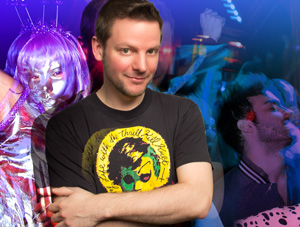FOF #988 – A Mysterious Roll of Pink Material
Marc Felion
May 17, 2009 ·
1985 views
Premium Content
You need to be a Feast of Fun Plus+ member to access this.
Join now
or Log in – it's easy!
High heel shoes, a Louis Vuitton bag held by an arm coming from a man’s nose, a mysterious roll of pink material, a Don Rickles cut out, and a drag queen dressed up as a […]
Loading...
 FOF #2400 – Lemme See What’s On Your Phone – 10.02.16
FOF #2400 – Lemme See What’s On Your Phone – 10.02.16 FOF #2356 – Into the Woods – 07.12.16
FOF #2356 – Into the Woods – 07.12.16 FOF #1890 – 30 Years of Berlin – 11.04.13
FOF #1890 – 30 Years of Berlin – 11.04.13 Stars: Celebrate Drag Queens in New Music Video
Stars: Celebrate Drag Queens in New Music Video
Comments
That was a great show… a bit vicious but all in good fun… Way to go Eric.. You have such a good phone Voice. Call me later…
And Fausto… I would agree that Duchamp was the DADA darling and one hell of a Drag persona as Rrose Sélavy… but It was F. T. Marinetti who was the front runner of the Futurist movement that ushered in DADA not Duchamp… But being a POP star in his age would make it seem that way HU… XXX
Here’s a nice easy to read article about Marcel Duchamp’s gay/artistic legacy:
http://www.glbtq.com/arts/duchamp_m.html
In many ways Duchamp’s radical ideas and artwork laid the foundation for everything else to come, and how we think of ourselves today. Much of Duchamp’s work challenged the concepts of identity, gender, and sexuality. When we think of gay men having an artistic sensibility, we owe a great deal to this man. Reality tv, social media, and thinking of art as an idea can all be traced back to his work.
And he made a pretty lady too. You better work — Rrose Sélavy!
There are several schools of thought as to who the “father”, “mother” or “godfather” of Dada is/was. According to the documentary “GERMANY : DADA” from Museum Without Walls (1968), if you examine Dada by country (Germany, Italy, France, Switzerland, etc.), they were all pursuing quite different forms of expression with differing motivations which all fell under the umbrella term: DADA. According to the Dada issue of ART IN AMERICA (June/July 2006), Carroll Janis suggests that – like a pop star – Dadaism was just one of many popular Bohemian art forms/movements/scenes that DuChamp dabbled in. While Sue Taylor suggests that in comparison, the German/Jew, John Heartfield (who I named on the show), was a true or pure Dadaist in that he developed collage into photomontage as a vehicle for his indefatiguable critique of the bourgoisie, the German media and the Nazi party. Also a Communist, Heartfield, on 16 April 1933, fled from the SS on foot. He jumped out of the window of his Berlin apartment and WALKED over the Sudeten Mountains until reaching the safety of Prague. This was the story I was poised to tell on FOF, but I suppose stories about drag queens are more appealing than stories about political dissidents.
That story is fabulous. I wish you had brought up that story in the pre-interview, we certainly would have made room for it.
I just saw you updated the demolish of the sex park in China. I came across this website while looking up info about the sad destruction of the sex park. The 9 most baffling theme parks from around the world. The fake Disney is my favorite: http://www.cracked.com/article_15955_9-most-baffling-theme-parks-from-around-world.html
Marc! I thought everything was supposed to be about ME! ME, dammit! Just ME! LOL!
Hey Buddy, you were just fine. Very humorous. I was quite proud to call you my friend. Keep kick’in ass! Rock-On, my brother! TTUL! C-2!
Thanks, Chuck!
Just to be clear, I never claimed Marcel Duchamp to be the father of anything, but more that he laid the foundation for the way we think of ourselves and the world around us today.
He’s MY baby daddy!
Was it just me or did anyone else find this particular show a little uncomfortable?
I’m with you Alfonzo. A bit tense, but interesting.
No, Fausto, you didn’t call say “father”, you called DuChamp “king”. And later used the phrase “gave birth”.
Gave birth to what?
Wonderful interview. Erik is a brilliant artist , very knowledgeable of the underground art scene and always a blast to have around. Art should push boundaries and taboos to inspire others to look past the limitations of their conventional beliefs and inhibitions and and allow the viewer to express themselves.
Kudos to Erik for expressing a frustration I have myself – that everyone has become a photographer in this digital camera age and they all try to document nightlife and that it is ruining nightlife in many ways. To document nightlife is more than taking a fabulous VAIN photo at a party. Nan Goldin photographs her friends and in knowing the subjects in her images there is an honesty in her photography. If you document something you can’t just pass through and take pictures. You have to befriend, even sometimes study and understand the surroundings and people you are trying to document. That’s what sets nightlife photojournalism apart from just a vanity snapshot.
Thanks, George! You’re the best.
London DJ, drag queen, nightclub promoter and tv personality Jodie Harsh (named one of the top 100 queers who pushed culture in 2008 by OUT Magazine) and brilliant performance artist Scottee have come up with an interesting answer to the camera in clubs quandry. A monthly party at London’s Electic Showroom called ISSUE:
http://issueclub.blogspot.com/
Over the course of an evening, the hostesses actually create a magazine via photo-documentation and video interviews of party-goers presenting the results in the form of a blog. (See link above.) I think this is great. It transforms all that hubris and vanity that drives me crazy into something creative, informative and productive. An innovative and modern way to document a night out.
Cool- where in the IML complex is your art show? If I make it down there tomorrow I want to see it. Today, we were in an out so quickly.
It was last night only in the Grand Foyer on the second level. Sorry if you missed it. I was told it would be on display all weekend. Just another thing the Leather Archives and Museum lied about. It turned out to be more of a jacket sale than an art exhibit.
Da Da means yes yes in Romanian and really orginates from Vienna and the Cabaret Voltaire with people like Hugo Bal, Tristram Tzara and they were performance artists. They were anti-art. Anti establishment. There is a CD around of their early performances which involve electronic sounds, shouting, meaningless words, poetic noises and lots of audience participation. Anarchy if you like, choosing to avoid systems, ideologies.
Frank Zappa called his art Zappa and Frank was the first composer/musician to put gay men and gay acts on stage. As in Mark Volman and Howard Kaylan. Bi-sexuality was a constant theme in Zappas performances and voices as in men singing in counter tenor etc.
Sorry should be Zurich not VIENNA